An easy mapo tofu recipe that creates the authentic taste of China that features soft tofu cooked in a rich, spicy, and savory sauce that is full of aroma. Serve it over steamed rice for a quick, delicious and healthy weekday dinner!
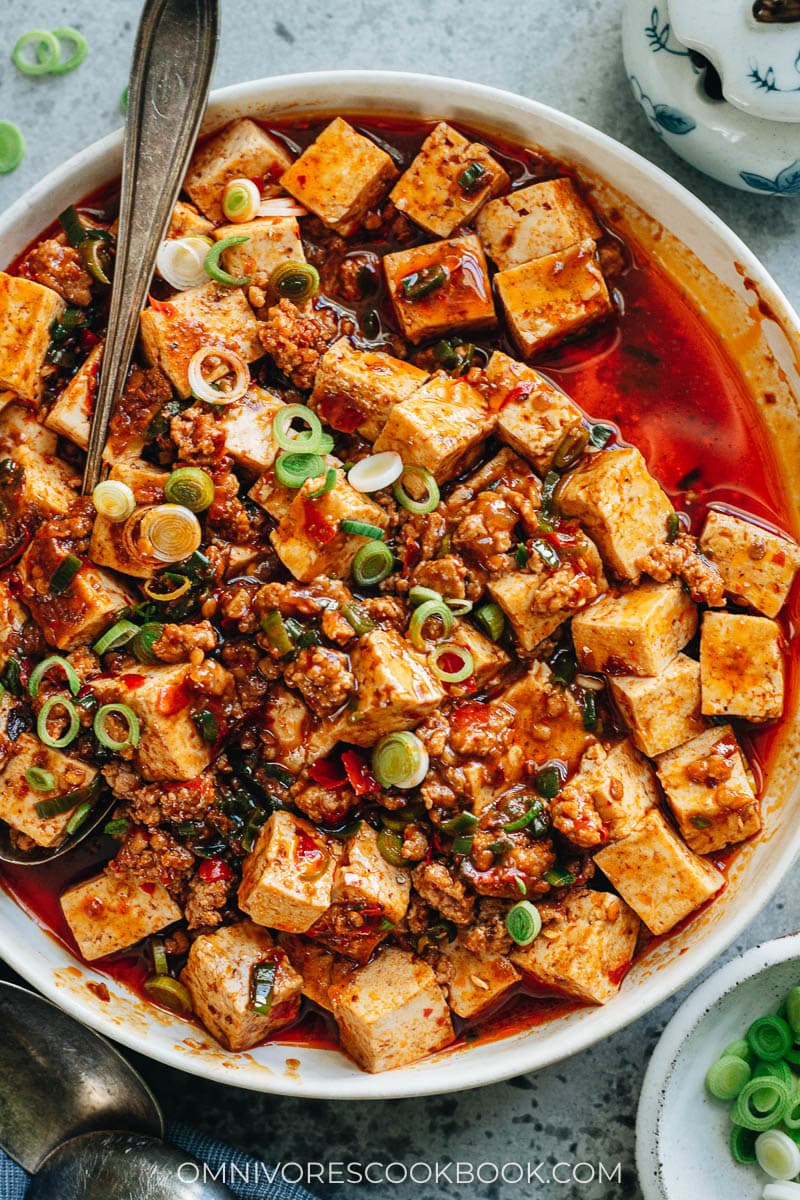
Mapo tofu (麻婆豆腐, ma po dou fu) is one of the most popular dishes from Sichuan cuisine. The tofu pieces are braised in a rich spicy, and savory sauce along with fresh garlic and scallions, with a small amount of ground pork to enhance the flavor. The dish is so appetizing and it goes perfectly with steamed rice.
Cooking mapo tofu is quite easy but you do need a few special ingredients to get the authentic flavor. I’m sharing my favorite mapo tofu recipe below. It creates the very authentic taste that you’d get at a restaurant in China. However, based on this recipe, you can easily tweak the dish according to your preferences.
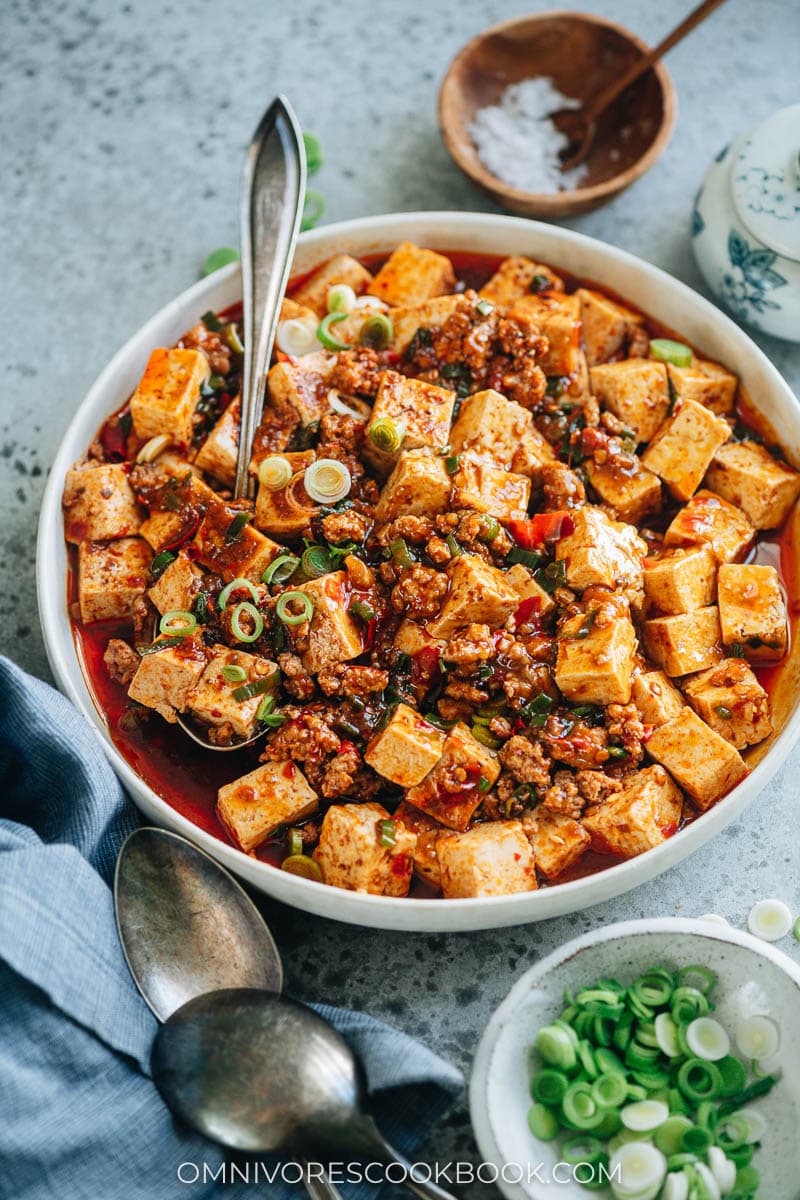

Key ingredients for Mapo Tofu
Doubanjiang
Doubanjiang (豆瓣酱), also known as spicy fermented bean paste or broad bean sauce, is the most important ingredient in mapo tofu. And it has a strong fermented savory, salty and spicy taste. Try to find “Pixian Broad Bean Paste” at your Asian market. Pixian is a small county in Sichuan province that produces the best broad bean paste. If you’re using this brand, you’re already halfway there. You can also purchase this brand on Amazon here.
NOTE: Depending on the brand of Doubanjiang you use, the salt and spiciness level can vary a lot. This dish is designed to be served with rice, so it’s on the salty side. If you want to make your dish less salty and spicy, reduce the amount of Doubanjiang (to 2 tablespoons).
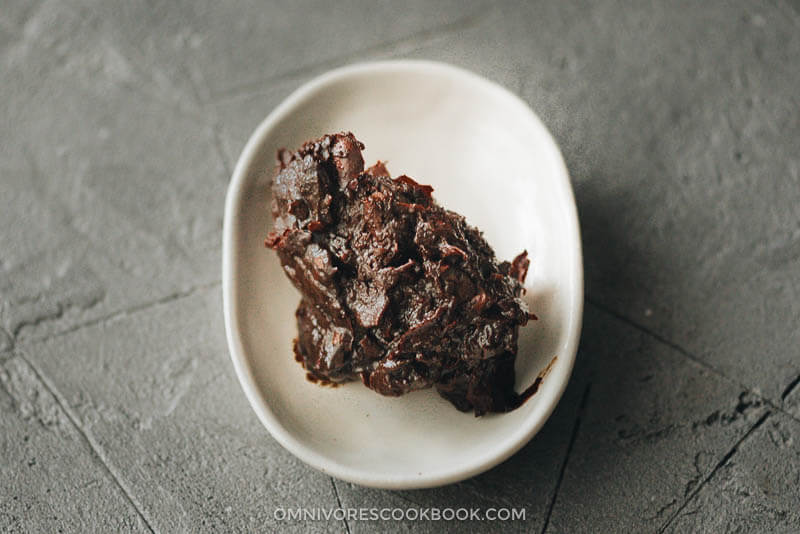
Sichuan peppercorns
Sichuan peppercorn (花椒, hua jiao) is another main ingredient in any Sichuan dishes. It has a citrusy taste with a numbing tingling sensation when you chew on it. It’s a secret to add aroma to your dish that no other ingredient can replace. You can purchase Sichuan peppercorns at Asian grocery stores, but I highly recommend these premium fresh ones from The Mala Market.
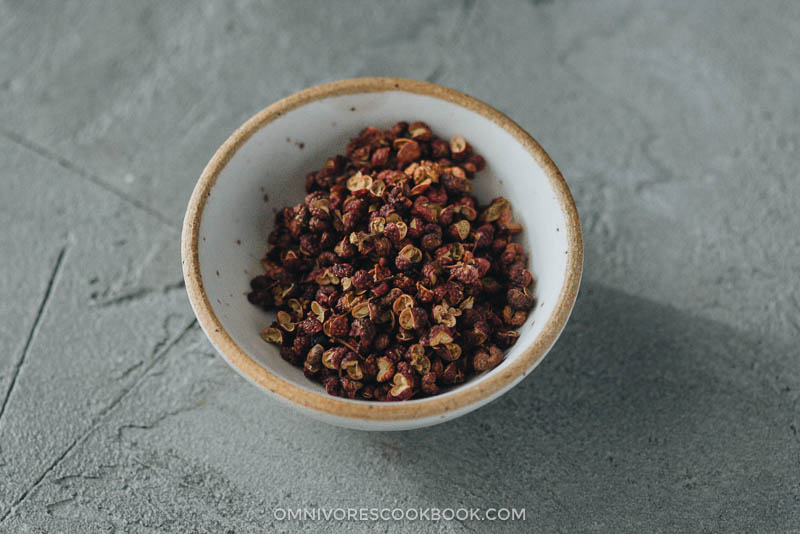
Homemade chili oil
The other important ingredient is chili oil (辣椒油). Although you can purchase bottled chili oil at the grocery store, I highly recommend you make it at home. Freshly cooked chili oil tastes much better than store-bought and is free of additives. You only need a few minutes to cook it and it is really easy. You can find an easy chili oil recipe here. And if you prefer to purchase it instead of making your own, you can also find it on Amazon.
PS. You will usually cook more chili oil than you’re able to use in one meal. You can store the extra oil in an airtight container in the fridge for 6 months up to a year. You can use the chili oil in various dishes, including bang bang chicken, dan dan noodles, Sichuan spicy wonton in red oil, and Fu Qi Fei Pian (Sliced beef in hot sauce). You can also add it into a dipping sauce for potstickers, or add it to wonton soup to enhance the flavor, or even put it on oatmeal!
It might look like you need so many specialty ingredients for this one dish. But trust me, if you love Sichuan food, you’ll be using them again and again.
How to cook mapo tofu
Once you gather the ingredients, making mapo tofu is a super easy process.
- Fry the Sichuan peppercorns in the oil to infuse the aroma
- Cook the ground pork with doubanjiang
- Once the pork is cooked, add the green onions and stir a few times
- Add the broth and braise with the cover on
- Drizzle in the cornstarch slurry to thicken the sauce
That’s it! I think this is one of the easiest Sichuan recipes and the result is super rewarding 🙂

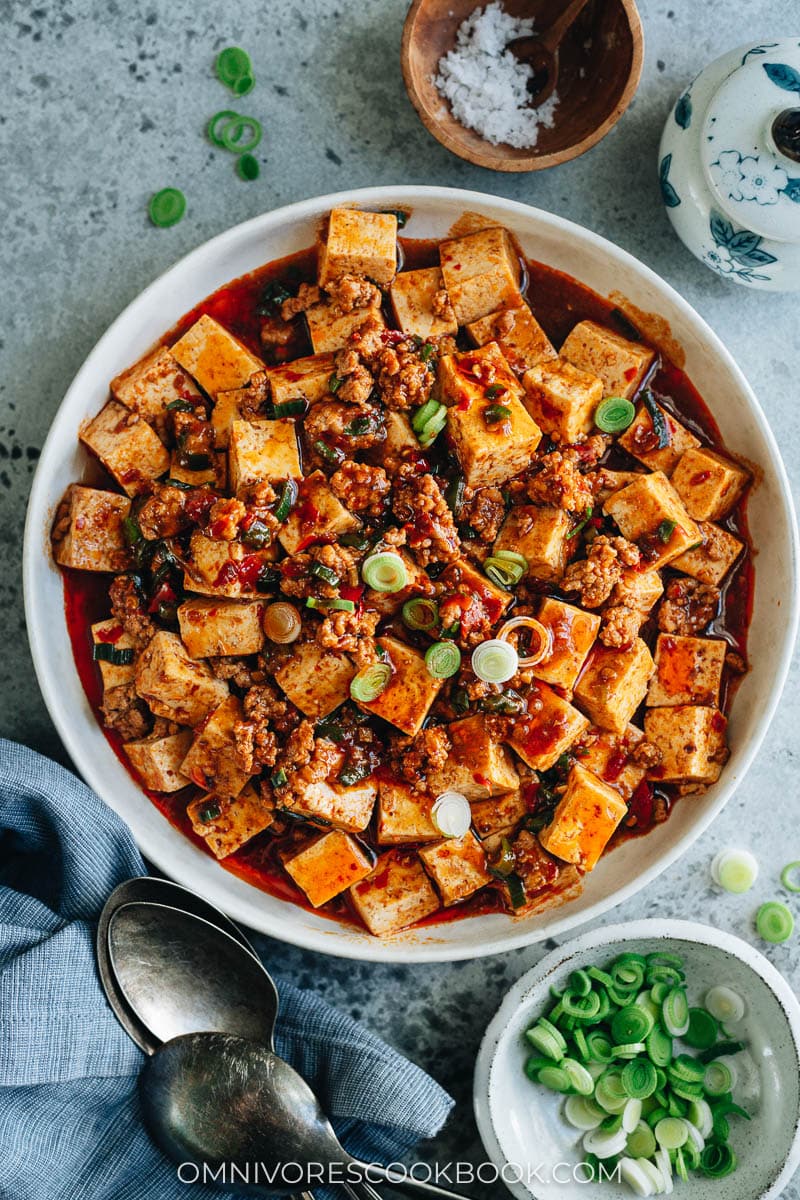
Frequently asked questions
What type of tofu to use for mapo tofu
There is no correct answer to this, and you should choose what works best for you.
Some Chinese restaurants, including many in China, prefer to use soft or silken tofu to make this dish. It creates a very silky tofu texture that melts in your mouth. This method does require some experience in handling tofu, so you won’t break apart the very delicate silken tofu while cutting and cooking.
On the other hand, you can also use extra firm, firm or medium tofu for this dish. These types of tofu are much easier to handle. Plus, once you braise it in the rich spicy sauce, it absorbs a lot of flavor and tastes great.
Do I need a wok to cook mapo tofu?
Not at all! I found it’s easiest to cook mapo tofu in a nonstick pan. The tofu will sit flat in the broth and absorb all the flavor. Not to mention it won’t stick to the pan easily or fall apart when you stir it.
Can you recommend a gluten-free doubanjiang?
Doubanjiang usually contains fermented wheat, which is not gluten-free. Unfortunately I hadn’t found a great tasting gluten-free doubanjiang at the time of writing this post.
There is a Japanese brand doubanjiang that’s gluten-free and I see it quite often at Asian markets and on Amazon. Compared to the Chinese brand, this one is quite salty and has less fermented taste. If you decide to use this one for your mapo tofu, you should reduce the amount (to 2 tablespoons) so your dish won’t end up too spicy and salty.
How to make mapo tofu vegetarian or vegan?
I have a vegan mapo tofu here that tastes super flavorful and great!
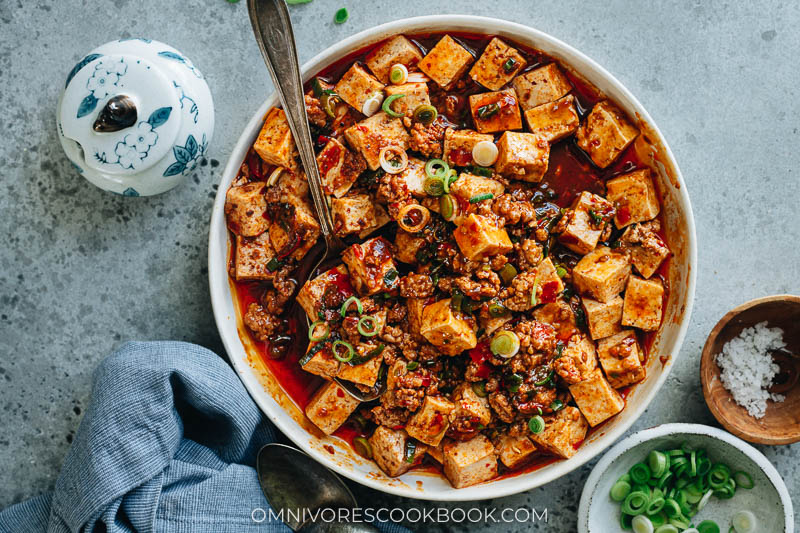
How to serve mapo tofu
I love cooking mapo tofu for a quick lunch or dinner and serving it over steamed rice. Sometimes I double the meat and sauce, so it will be enough to serve two people as a one-dish meal. I also like to add a handful of greens (spinach, garlic chives, or other tender greens such as chopped up baby bok choy) at the end of braising before adding the cornstarch, to create a more nutritious and balanced meal. Sometimes I also replace the ground pork (used in the authentic version) with ground turkey to cut calories.
For special diets, you can make it less spicy and skip the rice so it will be paleo-friendly. You can also make it into a vegan dish by replacing the meat with mushrooms.
Yes, mapo tofu is such a versatile dish!
Other Sichuan dishes to make a full-on Sichuan feast
- Dan Dan Noodles (担担面)
- Chinese Bang Bang Chicken (棒棒鸡)
- Stir-Fried Pea Shoots with Garlic (蒜蓉炒豆苗)
- Chinese Garlic Green Beans
- Shui Zhu Yu (Sichuan Boiled Fish, 水煮鱼)
- Chinese Pickled Cabbage (A Quick Pickle Recipe)

Authentic Mapo Tofu (麻婆豆腐)
Ingredients
Marinating
- 4 oz (120 g) ground pork (or chicken, or turkey) (*Footnote 1)
- 2 teaspoons Shaoxing wine (or dry sherry)
- 1 teaspoon light soy sauce
- 1/2 teaspoon minced ginger
For braising
- 1 teaspoon cornstarch (optional) (*Footnote 2)
- 2 teaspoons Sichuan peppercorns , increase to 3 teaspoons if you like your dish extra numbing, or reduce to 1 teaspoon if your Sichuan peppercorns are extra fresh
- 1 tablespoon peanut oil (or vegetable oil)
- 3 tablespoons Doubanjiang , reduce to 2 tablespoons for a less saltier and less spicy taste
- 2 green onion , chopped
- 1 block (400-g / 14-oz) firm or medium firm tofu , cut into 1.5cm (1/2 inch) squares
- 1 cup chicken stock (or water)
- 2 teaspoons homemade chili oil (*Footnote 3)
- 1/4 teaspoon five-spice powder
- 1 teaspoon sugar (or to taste)
Instructions
- Combine ground meat, cooking wine, soy sauce, and ginger in a small bowl. Mix well.
- Combine cornstarch with 1 tablespoon of water in a small bowl. Mix well and set aside.
- Heat the oil and Sichuan peppercorns in a large nonstick skillet over medium-high heat. When the Sichuan peppercorns turn dark brown and crispy, scoop them out with a spatula and transfer into a bowl layered with paper towels to soak extra oil. Save to use for garnishing the dish (Optional).
- Add the ground meat and Doubanjiang. Cook over medium heat and chop the ground meat into small bits with a spatula, until pork is evenly coated with Doubanjiang and fully cooked through. Add green onion and stir fry for another minute.
- Spread tofu evenly on top of ground pork (*Footnote 4). Add chili oil, five-spice powder, and sugar. Pour in the broth and cook until brought to a simmer. Simmer, covered, over medium-low heat for 8 to 10 minutes, or until the sauce has reduced to half the original amount. Taste the tofu with some broth (be careful, it will be very hot!). Adjust seasoning by adding salt if needed. If the dish is too spicy, add another teaspoon of sugar to balance it out. Gently mix well with spatula.
- (Optional) Meanwhile, grind the fried Sichuan peppercorns (you used when heating up the oil) in a coffee grinder or using mortar and pestle.
- Mix cornstarch water again until fully dissolved and swirl it into the skillet. Gently stir a few times with a spatula, until sauce thickens. Turn off heat and transfer everything to a bowl.
- Garnish with extra green onion and a small pinch of the ground Sichuan peppercorns, if using (*Footnote 5), if using. Serve hot over steamed rice or by itself as main.
Notes
- You can skip the meat and make this dish vegetarian. In this case, I highly recommend replacing the meat with mushrooms (such as rehydrated dried shiitake mushrooms) to enhance flavor.
- If you like the tofu with more broth, you can braise the tofu for a shorter time and use the cornstarch slurry to thicken the broth. Alternatively, you can uncover and braise until most of the liquid evaporates. The tofu will absorb more flavor this way.
- You can also pour on more chili oil for the restaurant look!
- Do not stir the tofu immediately after adding it into the skillet, in order to keep the pieces from breaking apart. The tofu will get firmer after braising and you can stir it once it’s cooked.
- The Sichuan peppercorns add a numbing nutty aroma to the dish. The fried Sichuan peppercorns have a more rounded body so it works great for garnishing the dish or in a salad. You only need a small amount in this recipe to finish up the dish. Store the rest in an airtight container, no longer than a month.
Video
Nutrition
The recipe was posted in Sep 7, 2015, and updated on May 23, 2022 with new graphics.














I make this recipe all the time. Easy and delicious. Thank you for sharing this recipe
Let’s start with the bad and it’s only a small bad, the slider for “servings” didn’t change the 120g of pork mine. The obsession to stick with Imperial measurements, when most of the world has converted to metric is such an PITA for non-Imperial cooks, which is most of us, so a conversion switch, which many sites use these days would be much appreciated. So the first attempt, I had twice as much pork as I should have in it, because the 120g didn’t drop to 60g…it was still lovely, but felt out of balance. The second attempt, now with the right ratios was infinitely better, incredibly moreish and definitely a keeper. Your photo does have far more liquid/oil than either of my attempts (thickening slurry or not), so I do wonder whether I’ve made a mistake on that front, so any suggestions would be greatly appreciated.
Thanks for your feedback! I do want to change the slider for metrics (I’m from a country that uses metrics too), but it’s a pretty big project that I’ve been holding off (need to find a web designer first, then manually update over 700+ recipes). It’s something I plan to work on the next year.
For the chili oil part, I did “cheated” when I did the photoshoot, by using more chili oil for a look that resembles more to the restaurant version. I personally never use that much oil at home, because it doesn’t affect the taste that much, and it’s not very healthy. The amount of sauce is more nuanced. If you use a large skillet and braise with higher heat, the liquid would evaporate a lot and you will have very little sauce left at the end. If you want more sauce, you can either (1) use more chicken broth, or (2) reduce the heat, or braise for slightly less time. If you use a cornstarch slurry at the end, the sauce will thicken and coat the tofu, so it will still taste flavorful with a shorter braising time.